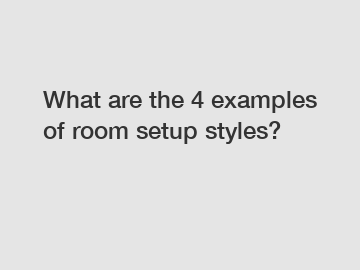What are the 4 examples of room setup styles?
What are the 4 examples of room setup styles? Well, there are four common room setup styles that are widely used in various events and occasions. These styles include classroom, theater, banquet, and boardroom setups.
Firstly, the classroom setup style is commonly seen in educational settings. It involves rows of tables and chairs facing towards the front of the room, facilitating a focused and interactive learning environment. This style is particularly beneficial for workshops, seminars, and training sessions, as it allows participants to easily take notes and engage in group discussions.
Secondly, the theater setup style is often used for presentations, lectures, and performances. In this setup, rows of chairs are lined up facing a stage or focal point. This layout enables maximum visibility and ensures that the audience can fully concentrate on the speaker or performer. The theater setup is commonly employed in large conference halls, theaters, or auditoriums.

The banquet setup style is commonly observed at social gatherings, weddings, galas, and dining events. It typically involves round tables with chairs placed around them, creating an intimate and social atmosphere. This style encourages interaction and conversation among attendees, making it suitable for networking events and celebrations.
Lastly, the boardroom setup style is commonly adopted for meetings and discussions in professional settings. It usually consists of a long rectangular table with chairs placed around it. This arrangement promotes a formal setting where participants can easily communicate and exchange ideas. The boardroom setup is often used in corporate meetings, board meetings, and negotiations.
The choice of room setup style depends on various factors, such as the purpose of the event, the number of attendees, and the desired atmosphere. Each setup style has its own advantages and can greatly impact the overall experience of the participants.
The classroom setup style, for example, fosters an environment conducive to learning and collaboration. It ensures that everyone has a clear view of the presenter and provides ample space for note-taking and group activities. This promotes active participation and engagement among participants, resulting in more effective knowledge transfer.
On the other hand, the theater setup style is ideal for events where the focus is primarily on the speaker or performer. By providing a clear line of sight, this setup enables the audience to fully concentrate on the presentation or performance. It creates a professional and impactful atmosphere that is essential for conveying important messages or entertaining the audience.
The banquet setup style emphasizes social interaction and encourages networking among attendees. By placing individuals in close proximity, this setup style facilitates conversations and fosters a sense of community. It is particularly beneficial for events that aim to create meaningful connections and build relationships.
The boardroom setup style promotes a formal and professional environment. It enables participants to easily communicate and collaborate, making it conducive to productive discussions and decision-making. This setup style ensures that everyone has a seat at the table, emphasizing equality and inclusiveness.
In conclusion, the four examples of room setup styles - classroom, theater, banquet, and boardroom - cater to different needs and objectives. Each style has its own advantages in terms of functionality, atmosphere, and impact. When organizing an event, it is essential to carefully consider the purpose and desired outcomes in order to select the most appropriate room setup style.
If you are looking for more details, kindly visit wireless conference room solutions, video wall matrix, Network Audio System.



Comments
0